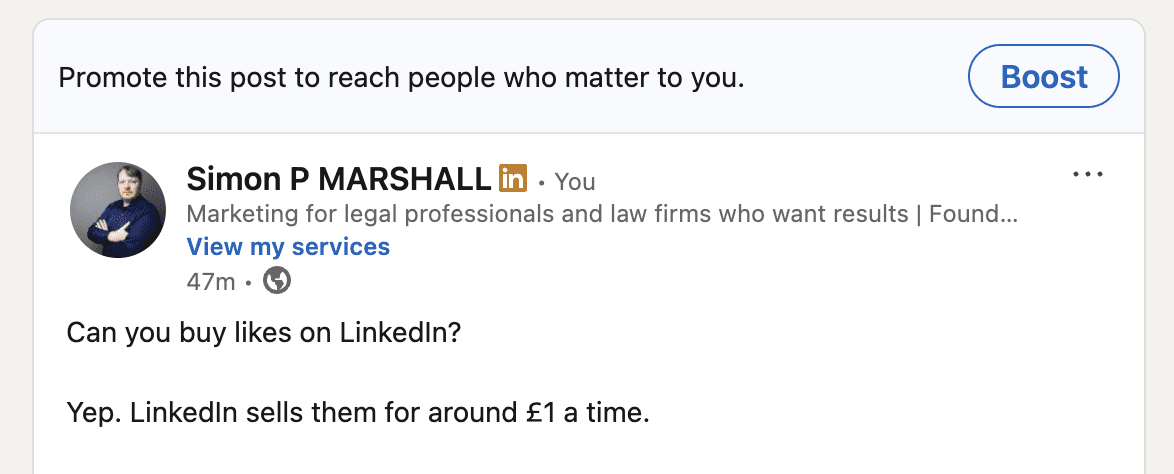LinkedIn has quietly rebuilt its brain.
The change isn’t cosmetic. It’s not about hashtags, dwell time or post length. The company has replaced the complex web of ranking algorithms that used to decide what appears in your feed with a single, text-driven model called 360Brew. It’s large, language-based, and designed to understand meaning rather than metadata.
This matters. For the first time, LinkedIn’s systems now read your words — the way a person would — before deciding who should see them.
For lawyers and law firm marketers, that changes the job. Visibility now depends less on tricks and timing, and more on clarity, consistency and expertise.
From engineered features to reading comprehension
To grasp what has changed, think of LinkedIn’s old algorithm as a machine stitched together from thousands of separate models. Each had a specific job: predict what you might click on, who you might connect with, what you might like, and so on. Every task required its own data engineers, features and maintenance. It worked, but it was messy.
360Brew replaces all that with a single foundation model — the same architecture used in large language models such as GPT. It is “decoder-only”, which means it works by predicting the next word in a sequence, but it does this across every LinkedIn surface: feed, jobs, connections, search, recommendations.
The key difference is that the model now uses language as its interface. Instead of being fed rigid IDs, it ingests and interprets text: profiles, job descriptions, posts, comments, interactions. That means it can understand a member’s world semantically, not just statistically.
Where the old system saw you as a series of codes — job title, company, geography — the new one reads you as a person with a professional narrative.
A shift from engineering to understanding
This model is trained on textual representations of how people behave: who reads what, what they apply for, what they comment on, what they scroll past. It treats those interactions as sentences in a story — a professional history written in clicks and words.
The advantage is flexibility. Because 360Brew understands language, it can apply its reasoning to new situations without being retrained. A model built to rank job posts can also rank thought leadership. It can generalise.
For users, that means the system is no longer limited to who you’ve engaged with. It can make nuanced inferences about what content fits your interests or expertise — even if you’ve never interacted with that person before.
Why this matters for lawyers
The implications for the legal sector are significant.
Lawyers have always been good at logic but cautious about language. Most posts are written as if LinkedIn still rewards presence over precision — something between a press release and a diary entry. But 360Brew rewards something different: semantic clarity.
It looks for signals of expertise and topical coherence. If your post describes a specific issue — “what the FCA’s new rules mean for crypto exchanges”, for instance — the model can match it to members who read, post or comment on similar material. It no longer needs to rely on their job title or firm.
Vague posts, by contrast, leave it guessing. “Leadership lessons from lockdown” could come from a lawyer, a coach or a gym owner. The model doesn’t know who to show it to, so it doesn’t show it widely.
That means writing well has become a visibility strategy, not a virtue.
For law firm marketers: the end of feature engineering
For digital marketers and CMOs, 360Brew changes how content strategy should be built.
The old game was to feed the algorithm: right post length, right timing, right hashtag density. That is now almost irrelevant. The model doesn’t rank posts by format but by meaning.
In technical terms, 360Brew replaces “feature engineering” with “prompt engineering”. In practice, that means your opening paragraph now acts as a signal: it tells the system what the post is about, who should see it, and why it matters.
If your first three lines don’t convey a clear topic and professional context, the model can’t categorise it accurately — so the post sinks.
The same applies to company pages. Generic headlines (“Proud to announce…”) are invisible. Contextual ones (“We advised on the UK’s first sustainability-linked bond dispute”) are understood. The system reads and routes them accordingly.
This shift also favours firms that post with consistent thematic depth. A sporadic mix of unrelated topics — one post on ESG, the next on recruitment drives, the next on firm socials — builds no semantic profile. The model can’t tell what your firm stands for. A steady cadence around a few distinct subjects helps it learn and amplify your authority.
How 360Brew learns and why cadence matters
The model learns through what it calls “many-shot learning” — effectively, pattern recognition from repeated exposure. The more often you post about a topic, the more context the system gains about you and your audience. That history improves its predictions about who should see your future posts.
For individuals, that means consistency beats virality. You don’t need to post daily, but you do need to post reliably and recognisably. A rhythm of two or three posts a week on clear topics builds enough data for the system to trust its own judgement about your relevance.
Think of it like a client relationship. The more often you show up with something useful to say, the easier it is for them to remember what you do.
The cold-start problem — and how clarity solves it
Traditional recommendation systems struggled with “cold starts”: new members, new firms, or new topics that lacked interaction data. 360Brew handles that by understanding content textually. It can infer relevance from meaning, not history.
That’s good news for junior lawyers, new firms, or those starting to build their voice. If your content is clear and topic-driven, it can find its audience faster than before.
But it also means the system is less forgiving of vagueness. Early posts that try to “sound professional” rather than say something precise will simply be misrouted. Better to start narrow and expand later.
What the algorithm now values
In short, 360Brew ranks posts using three broad signals:
- Meaning: Does this post have a clear, specific subject that the system can map to audience interests?
- Consistency: Has this person or firm posted reliably on related topics before?
- Engagement relevance: When people engage, do they resemble the audience the model expected?
This is not an engagement arms race. A post that earns fifty relevant reactions will now outperform one with five hundred off-topic likes.
The opportunity for professional voice
This change plays to the strengths of lawyers — if they use them. The best legal writing is already clear, analytical and specific. The worst LinkedIn writing is the opposite. 360Brew simply exposes the gap.
The winners will be those who combine professional clarity with human tone: concise sentences, real examples, moderate confidence.
Overwritten posts or self-congratulation will be filtered out, not for moral reasons, but because the system reads them as semantically thin.
In essence, the algorithm now behaves like your ideal reader: time-poor, intelligent, sceptical.
How to adapt
For lawyers:
Write as if LinkedIn were a well-briefed client — informed, impatient and allergic to fluff.
Use your first paragraph to declare topic, context and value.
Post within recognisable lanes: your specialism, your market, your client themes.
For law firm CMOs and digital teams:
Rebuild editorial calendars around topic clusters, not campaigns.
Measure consistency and audience alignment, not just impressions.
Drop formulaic hashtags and corporate phrasing. The system reads language, not symbols.
And for everyone:
Stop trying to “game” the feed. The game has changed.
The bottom line
360Brew is less an algorithm tweak than a philosophical shift. LinkedIn has moved from modelling behaviour to understanding meaning.
For years, users have been told to “be authentic” or “show personality”. That advice is now redundant. The platform doesn’t need you to perform; it needs you to be clear.
Clarity has become the new visibility.
If you want the algorithm — and your audience — to remember you, say something worth understanding. And say it well.





